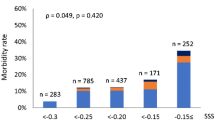Abstract
Overwhelming surgical stress exceeding a patient’s reserve capacity causes a disruption of homeostasis, leading to various postoperative complications. This study was under-taken to develop a new scoring system, “E-PASS”, standing for the Estimation of Physiologic Ability and Surgical Stress, that predicts the postsurgical risk by quantification of the patient’s reserve and surgical stress. E-PASS comprises the preoperative risk score (PRS), the surgical stress score (SSS), and the comprehensive risk score (CRS) that is determined by both scores. These scores were computed by a multiple regression analysis conducted on 292 consecutive patients who underwent elective common gastrointestinal operations at one hospital between 1992 and 1995 (internal group). The usefulness of the scores was evaluated in 989 consecutive patients who underwent the same surgical procedures during the same period at another hospital (external group). The morbidity and mortality rates increased similarly in both groups as the CRS increased. A marked step-up of both rates was observed at a CRS>1.0, reaching mortality rates of 20% in the internal subjects and 28.5% in the external subjects. These results suggest that the E-PASS scoring system is reproducible, and that it may be useful for surgical decision making. This system requires no special examinations and can be used in every hospital.
Similar content being viewed by others
References
Ogawa M (1996) Mechanisms of the development of organ failure following surgical insult: the “second attack” theory. Clin Intens Care 7:34–38
Sakamoto K, Arakawa H, Mita S, Ishiko T, Ikei S, Egami H, Hisano S, Ogawa M (1994) Elevation of circulating interleukin 6 after surgery: factors influencing the serum level. Cytokine 6:181–186
Yokota K, Nishihara T, Shineha R, Sayama J, Nitta Y, Kimura M, Mori S (1995) Association between elevated plasma granulocyte colony-stimulating factor and the degree of surgical stress in patients undergoing gastrointestinal surgery. Surg Today 25:579–584
Haga Y, Beppu T, Doi K, Nozawa F, Mugita N, Ikei S, Ogawa M (1997) Systemic inflammatory response syndrome (SIRS) and organ dysfunction following gastrointestinal surgery. Crit Care Med 25:1994–2000
Buzby GP, Mullan JL, Mathews DC, Hobbs CL, Rosato EF (1980) Prognostic nutritional index in gastrointestinal surgery. Am J Surg 139:160–166
Goldman L, Caldera DL, Nussbaum SR, Southwick FS, Krogstad D, Murray B, Burke DS, O’Malley TA, Goroll AH, Caplan CH, Nolan J, Carabello B, Slater EE (1977) Multifactorial index of cardiac risk in noncardiac surgical procedures. N Engl J Med 297:845–850
Cooperman M, Pflug B, Martin EW Jr, Evans WE (1978) Cardiovascular risk factors in patients with peripheral vascular disease. Surgery 84:505–508
Saito T, Shimoda K, Kinoshita T, Shigemitsu Y, Miyahara M, Kobayashi M, Shimaoka A (1993) Prediction of operative mortality based on impairment of host defense systems in patients with esophageal cancer. J Surg Oncol 52:1–8
Yamanaka N, Okamoto E, Kuwata K, Tanaka N (1984) A multiple regression equation for prediction of posthepatectomy liver failure. Ann Surg 200:658–663
Noguchi T, Imai T, Mizumoto R (1990) Preoperative estimation of surgical risk of hepatectomy in cirrhotic patients. Hepato-Gastroenterology 37:165–171
Shimada M, Matsumata T, Akazawa K, Kamakura T, Itasaka H, Sugimachi K, Nose Y (1994) Estimation of risk of major complications after hepatic resection. Am J Surg 167:399–403
Zhang GH, Fujita H, Yamana H, Kakegawa T (1994) A prediction of hospital mortality after surgical treatment for esophageal cancer. Surg Today 24:122–127
Kanus WA, Draper EA, Wagner DP, Zimmerman JE (1985) Apache II: a severity of disease classification system. Crit Care Med 13:818–829
Copeland GP, Jones D, Walters M (1991) POSSUM: a scoring system for surgical audit. Br J Surg 78:356–360
Dawson-Saunders B, Trapp RG (1990) Basic and clinical biostatics, first edn. Appleton and Lange, Norwalk
Furue H (1986) Criteria for the direct effect of chemotherapy against solid cancer by Japanese Society for Cancer Therapy (in Japanese). Nippon Gann Tiryou Gakkai Zasshi (J Jpn Soc Cancer Ther) 21:931–942
Owens WD, Felts JA, Spitznagel EL (1978) ASA physiological status classifications: a study of consistency of ratings. Anesthesiology 49:239–243
Author information
Authors and Affiliations
Rights and permissions
About this article
Cite this article
Haga, Y., Ikei, S. & Ogawa, M. Estimation of physiologic ability and surgical stress (E-PASS) as a new prediction scoring system for postoperative morbidity and mortality following elective gastrointestinal surgery. Surg Today 29, 219–225 (1999). https://doi.org/10.1007/BF02483010
Received:
Accepted:
Issue Date:
DOI: https://doi.org/10.1007/BF02483010




